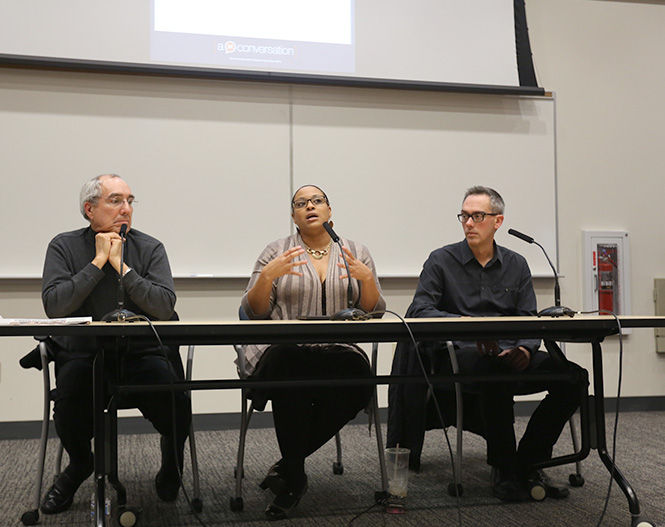JMC students and faculty discuss issues of race and diversity in the media
Associate Lecturer Traci Williams speaks at the Diversity Redefined event in the First Energy Room, October 22, 2014.
October 22, 2014
Faculty and students from the School of Journalism and Mass Communication (JMC) met the night of Wednesday, Oct. 22 to discuss the changing state of diversity and race in the media and in the world, at the Student Voice team’s Diversity (Re)Defined discussion.
A faculty panel comprised of Federico Subervi, JMC professor and provost faculty associate for AALANA Recruitment and Retention; Traci Williams, a Pan-African studies and JMC professor; and Evan Bailey, assistant JMC professor, answered students’ questions and offered their perspective as professionals in the industry. The discussion was led by JMC Director Thor Wasbotten.
Williams, who has had a successful career in television and film production, began by speaking about her experience with racism in the entertainment industry.
“What’s interesting about my profession,” Williams said, “is that when I walk on set, most people automatically think I’m there to do makeup.”
Diversity reports in Hollywood aren’t that great, she said, especially for women, African and Latino writers and directors.
Williams also discussed how African-Americans have been depicted differently in film since Obama was elected president in 2008, and mentioned the recent release of movies like “The Butler,” “12 Years a Slave” and “Django.”
From the entertainment industry, the conversation was then directed toward Bailey.
Bailey said although there’s not a lot of multiculturalism in his background, it was always something he knew was important. Bailey said diversity was something he approached with caution until he started working internationally and fell in love with it.
“You need to understand the world you’re walking into and create content for all these populations,” Bailey said.
Subervi then spoke about the changing demographics in the United States. Using an article from USA Today, Subervi mapped out the growing diversity in America from 1960 through 2060, emphasizing that diversity cannot be avoided.
“Unless you plan on only working in Montana and New Hampshire,” Subervi said, “you should learn something about the changing demographics.”
Looking around the already diverse room in Franklin Hall, Wasbotten said, we define diversity as whatever we perceive it as.
“Everyone has to understand, as we look to the person next to us, is that they have a story,” Wasbotten said.
Contact Kaitlin Siegel at [email protected].

























